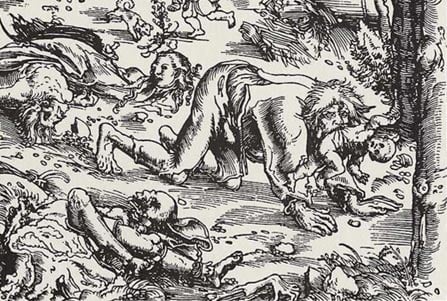Archaeology shows that these fierce women also smoked pot, got tattoos, killed—and loved—men.
An 1882 print shows an Amazon, perhaps Penthesilea, Queen of the Amazons, about to spear a panther.
The Amazons got a bum rap in antiquity. They wore trousers. They
smoked pot, covered their skin with tattoos, rode horses, and fought as
hard as the guys. Legends sprang up like weeds. They cut off their
breasts to fire their bows better! They mutilated or killed their boy
children! Modern (mostly male) scholars continued the confabulations.
The Amazons were hard-core feminists. Man haters. Delinquent mothers.
Lesbians.

Drawing on a wealth of textual, artistic, and archaeological evidence,
Adrienne Mayor, author of
The Amazons, dispels these myths and takes us inside the truly wild and wonderful world of these ancient warrior women.
Talking from her home in Palo Alto, California, she
explains what Johnny Depp has in common with Amazons, why the Amazon
spirit is breaking out all over pop culture, and who invented trousers.
We associate the word Amazon with digital book sales these days. Tell us about the real Amazons.
The real Amazons were long believed to be purely imaginary.
They were the mythical warrior women who were the archenemies of the
ancient Greeks. Every Greek hero or champion, from Hercules to Theseus
and Achilles, had to prove his mettle by fighting a powerful warrior
queen.
We know their names: Hippolyta, Antiope, Thessalia. But
they were long thought to be just travelers' tales or products of the
Greek storytelling imagination. A lot of scholars still argue that. But
archaeology has now proven without a doubt that there really were women
fitting the description that the Greeks gave us of Amazons and warrior
women.
The Greeks located them in the areas north and east of the
Mediterranean on the vast steppes of Eurasia. Archaeologists have been
digging up thousands of graves of people called Scythians by the Greeks.
They turn out to be people whose women fought, hunted, rode horses,
used bows and arrows, just like the men.
What archaeological proofs have been discovered to show that these mythical beings actually existed?
They've been excavating Scythian kurgans, which
are the burial mounds of these nomadic peoples. They all had
horse-centred lifestyles, ranging across vast distances from the Black
Sea all the way to Mongolia. They lived in small tribes, so it makes
sense that everyone in the tribe is a stakeholder. They all have to
contribute to defense and to war efforts and hunting. They all have to
be able to defend themselves.
The great equalizer for those peoples was the domestication
of horses and the invention of horse riding, followed by the perfection
of the Scythian bow, which is smaller and very powerful. If you think
about it, a woman on a horse with a bow, trained since childhood, can be
just as fast and as deadly as a boy or man.
Archaeologists have found skeletons buried with bows and
arrows and quivers and spears and horses. At first they assumed that
anyone buried with weapons in that region must have been a male warrior.
But with the advent of DNA testing and other bioarchaeological
scientific analysis, they've found that about one-third of all Scythian
women are buried with weapons and have war injuries just like the men.
The women were also buried with knives and daggers and tools. So burial
with masculine-seeming grave goods is no longer taken as an indicator of
a male warrior. It's overwhelming proof that there were women answering
to the description of the ancient Amazons.
Why were they called Amazons?
[Laughs.] That's such a complex story that I actually
devoted an entire chapter to it. It's the one thing everyone seems to
think they know about Amazons: that the name has something to do with
only having one breast so they could easily fire an arrow or hurl a
spear. But anyone who's watched The Hunger Games, or female
archers, knows that that is an absolutely physiologically ridiculous
idea. Indeed, no ancient Greek artworks—and there are thousands—show a
woman with one breast.
All modern scholars point out that the plural noun
"Amazones" was not originally a Greek word—and has nothing to do with
breasts. The notion that "Amazon" meant "without breast" was invented by
the Greek historian Hellanikos in the fifth century B.C.
He tried to force a Greek meaning on the foreign loan word: a
for "lack" and "mazon," which sounded a bit like the Greek word for
breast. His idea was rejected by other historians of his own day, and no
ancient artist bought the story. But it stuck like superglue. Two early
reviews of my book even claimed I accept that false etymology.
Linguists today suggest that the name derives from ancient Iranian or
Caucasian roots.

Amazons war on this fourth-century Greek vase.
You describe them as "aggressive, independent man-killers." Were Amazons also lesbians?
That is one of the ideas that have arisen in modern times.
Nobody in antiquity ever suggested that. We know that the ancient Greeks
and Romans were not shy about discussing homosexuality among men or
women. So if that idea had been current in antiquity, someone would have
mentioned it.
The one interesting artistic bit of evidence that I did
find is a vase that shows a Thracian huntress giving a love gift to the
Queen of the Amazons, Penthesilea. That's a strong indication that at
least someone thought of the idea of a love affair between Amazons. But
just because we don't have any written evidence and only that one unique
vase doesn't preclude that Amazons might have had relations with each
other. It's just that it has nothing to do with the ancient idea of
Amazons.
The strong bond of sisterhood was a famous trait in
classical art and literature about Amazons. But it was modern people who
interpreted that as a sexual preference for women. That started in the
20th century. The Russian poet Marina Tsvetaeva declared that Amazons
were symbolic of lesbianism in antiquity. Then others took that up. But
the ancient Greeks didn't think of them as lesbians. They described them
as lovers of men, actually. Man-killers—and man lovers.
You refer to the "Amazon spirit." What are its key characteristics?
I used that phrase in the dedication to a good friend of
mine, Sunny Bock. She was a strong figure who believed in equality
between men and women. She rode motorcycles, she rode horses, then
became the first female railroad engineer. She was a risk taker who died
an untimely death, probably because of her life of risk. She embodied
the Amazon spirit: the assumption that women are the equals of men and
that they could be just as noble and brave and heroic.
That comes through in the artworks and literature about
Amazons. The Greeks were both fascinated and appalled by such
independent women. They were so different from their wives and
daughters. Yet there was a fascination. They were captivated by them.
Pictures of Amazons on vase paintings always show them as beautiful,
active, spirited, courageous, and brave.
I talked to a vase expert whose specialty is gestures on
Greek vases. He has written an article about gestures begging for mercy
in single combat images. Quite a few of the losers in duels are shown
gesturing for mercy. But among Amazons, not so much. We have about 1,300
or so images of Amazons fighting. And only about two or three of them
are gesturing for mercy. So they're shown to be extremely courageous and
heroic. And I think that's the Amazon spirit.
Amazons smoked pot and drank a powerful concoction of fermented mare's milk called kumis, which they used in rituals. Put us around a campfire in ancient Scythia.
In that picture of the ancient Amazons sitting around their
campfire we also have to include men. We don't have any evidence that
there were whole societies with nothing but women. When we say Amazons,
we mean Scythian women. In this case Scythian warrior women.
Herodotus gives us a very good picture. He says that they
gathered a flower or leaves or seeds—he wasn't absolutely sure—and sat
around a campfire and threw these plants onto the fire. They became
intoxicated from the smoke and then would get up and dance and shout and
yell with joy. It's pretty certain he was talking about hemp, because
he actually does call it cannabis. He just wasn't certain whether it was
the leaves or the flower or the bud. But we know they used intoxicants.
Archaeologists are finding proof of this in the graves. Every Scythian
man and woman was buried with a hemp-smoking kit, including a little
charcoal brazier.
Herodotus also described a technique in which they would
build a sauna-type arrangement of felt tents, probably in wintertime on
the steppes. He describes it as like a tepee with a felt or leather
canopy. They would take the hemp-smoking equipment inside the tent and
get high. They've found the makings of those tents in many Scythian
graves. They've also found the remains of kumis, the fermented mare's
milk. I give a recipe in the book for a freezing technique they used to
raise its potency. [Laughs.] Do not try this at home.
They were also very big on tattoos, weren't they?
There are a lot of tattoos—beautifully, lovingly detailed
tattoos in images of Thracian and Scythian women on vase paintings.
Ancient Greek historians described the tattooing practices of the
culturally related tribes of Eurasia.
According to one account, Scythian women taught the
Thracian women how to tattoo. The Greeks had lots of slaves from the
Black Sea area, and they were all tattooed. They thought of tattoos as a
sort of punishment. Who would voluntarily mark their bodies? Yet once
again they had this push-pull attraction and anxiety about these foreign
cultures.
We also now have archaeological evidence that Amazon-like
women were tattooed. Tattoo kits been discovered in ancient Scythian
burials. The frozen bodies of several heavily tattooed Scythian men and
women have been recovered from graves. The famous Ice Princess is just
one example—her tattoos of deer call to mind the tattoos depicted in
Greek vase paintings.
Johnny Depp said, My skin is my journal, and the tattoos
are the stories. I think that's a good way to think of this. They could
have been initiations, they could be just for decoration, they could
represent special experiences, either in reality or dreams. We don't
really know. All we know is that they were heavily tattooed, mostly with
real and fantastical animals and geometric designs.
Kurdish women in a Peshmerga battalion, whom some
might seen as modern Amazons, take part in a training exercise near
Sulaymaniyah, Iraq, on September 17, 2014.
A question I have been dying to ask: Who invented trousers?
The Greeks credited three different warrior women with the
invention of trousers. Medea, a mythical sorceress and princess from the
Caucasus region, was credited with inventing the outfit that was taken
up by Scythians and Persians. The other two were Queen Semiramis, a
legendary Assyrian figure, and Queen Rhodogune, which means "woman in
red." The Greeks were not that far off. Trousers were invented by the
people who first rode horses—and those were people from the steppes.
Leg coverings are absolutely essential if you're going to
spend your life on horseback. Trousers are also the first tailored
garments. They were pieced together and sewn. The Greeks wore rectangles
of cloth held together with pins. They thought trousers were an
abomination worn by the barbarians. But once again, they're fascinated
by them.
In the vase paintings the Amazons have wildly spotted and
striped and checked leggings and trousers. One of the things I find most
interesting is that it was not just the men who rejected trousers.
Greek women didn't wear them either. Yet we find images of beautiful
Amazons in trousers on women's perfume jars and jewelry boxes. I think
there's something going on in Greek private life that we don't really
know about yet.
There was even an Amazon island, wasn't there?
Yes. It's the only island off the southern coast of the
Black Sea. It's now called Giresun Island. But it was first written
about in Apollonius of Rhodes's version of the epic poem The Argonauts.
As Jason and the Argonauts are sailing east on the Black Sea, they stop
at what they call Island of Ares or Amazon Island. There they see the
ruins of a temple and an altar, where they claim the Amazons sacrificed
horses and worshiped before they went to war.
This is really interesting, because it means the Greeks
were finding ruins associated with Amazons as far back as the Bronze
Age. It shows how real the Amazons were to them. Recently, Turkish
archaeologists found the altar and temple ruins that are mentioned in
Jason and the Argonauts.
They got a bad press in the ancient world, didn't
they? There were rumors that they maimed and even castrated young boys.
Separate the fiction from the fact.
The idea that Amazons abandoned, maimed, or killed young
boys is a fairly early story that circulated among the Greeks, because
several writers assumed that Amazon societies must be women only.
That then raised the question: How do they reproduce? They
came up with these stories of women agreeing to meet with neighboring
tribes to reproduce. But then what did they do with the boys? So there
were stories that they either maimed them so that they couldn't
participate in warfare or that they actually killed them to get rid of
them and only kept the girls.
The most common story was that they sent the boys back to
the fathers to be raised. Many modern scholars interpreted this as proof
that they abandoned their duties as mothers. They don't take care of
their babies! They give them away! Blah, blah, blah.
But it turns out that it was a very common custom among
nomadic people, called fosterage. Sending sons to be raised by another
tribe ensures that you're going to have good relations with that tribe.
It's a way of sealing treaties. It was very common in antiquity.
Philip the Great was raised by an ally of his father. It
was also common in the Middle Ages in Europe. It's also a way of
ensuring you don't have incest within the tribe. The fact that the
Scythian and Thracian tribes probably practiced fosterage led to these
stories that the Amazons gave their sons to the father's tribe. That's
probably a reality. But there is no archaeological evidence that they
maimed boys.
Tell us about modern-day Amazons.
Today's news from the Middle East and Syria is filled with
images of Kurdish Peshmerga women fighting IS. There are movies and TV
series featuring bold warrior women and even Amazons. It started with Xena: Warrior Princess, and then there were the animated films Brave and Mulan and The Hunger Games and the role of Atalanta in the Hercules film. The new Vikings TV show has all the shield maidens. And of course there are strong women in A Game of Thrones. So everyone's really aware of the idea of warrior women.
It's sort of fair to say that Amazons, both as reality and as a dream
of equality, have always been with us. It's just that sometimes that
fiery Amazon spirit is hidden from view or even suppressed. Right now
they're blazing back into popular culture.



























